Dubsea’s Joerael Elliott shares the poster:

January 27th, 2010 Tracy Posted in Arts, Beverages, Greenbridge, White Center news Comments Off on Music at Dubsea Coffee this Saturday night
Dubsea’s Joerael Elliott shares the poster:

January 18th, 2010 Tracy Posted in Greenbridge, Holidays, White Center news Comments Off on MLK Day in White Center: Red Cross and HOPE @ Greenbridge
(Cross-posted at partner site West Seattle Blog)

Story and photos by Keri DeTore
Reporting for White Center Now/West Seattle Blog
A joint event between the Southwest Boys and Girls Club, the Red Cross and HOPE worldwide at Greenbridge (map) combined messages of civil rights and disaster preparedness to honor and celebrate Dr. Martin Luther King, Jr., Day.
The event was kicked off by the Seahawks’ Blue Thunder drummers and an opening speech by North Highline Fire District Fire Chief Scott LaVielle. Chief LaVielle spoke about fire safety— which is being highlighted by the Red Cross — and quoted from speeches by John F. Kennedy and Robert F. Kennedy to highlight the importance of caring for our communities.
Red Cross Coordinator Beth Jusino notes that MLK Day is viewed by her organization as “A day on, not a day off” in service to the community. After the event, volunteers dispersed into the Greenbridge neighborhood to place door-hangers regarding fire safety and earthquake preparedness at the surrounding homes. The information is printed in both English and Spanish. (In case you’re not in the area flyered – here’s the Red Cross’s infopage on fire safety.)
Jusino adds that in light of the Haitian earthquake, people have opened their hearts to the world community; today, people are focusing on opening their hearts to their local community – and the volunteers who are spreading the word about helping each other, locally and globally.

January 5th, 2010 Tracy Posted in Arts, Beverages, Fun, Greenbridge, White Center news 1 Comment »

Greenbridge’s new Dubsea Coffee has announced its second art show, with a reception for artist Kelda Martensen coming up January 16th.
November 15th, 2009 Tracy Posted in Beverages, Greenbridge, White Center news 6 Comments »
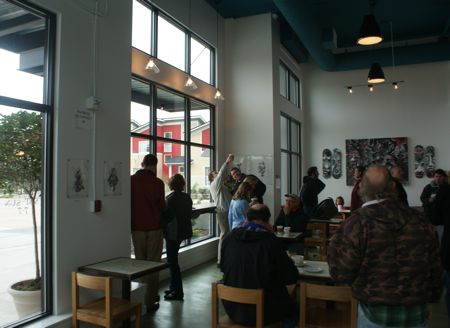
We stopped by on Saturday morning and this java joint was jumpin’. Beautiful space, as you can see from our photo showing just part of its interior. Today’s the second day of Grand Opening weekend – Dubsea Coffee is on 8th SW in Greenbridge, about a block south of Roxbury. ADDED SUNDAY NIGHT: Someone sent this cell-phone photo of amazing latte art from Dubsea today – wow!

November 9th, 2009 Tracy Posted in Beverages, Businesses, Greenbridge, White Center news 7 Comments »
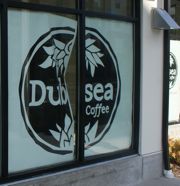 You’ve probably noticed the signs in the window in recent months – now it’s time to open the doors. It’s grand opening weekend this Saturday and Sunday for Dubsea Coffee in Greenbridge. We had the pleasure of meeting its proprietor Sibelle earlier this year; she plans for her coffee shop to be not just a place to get espresso, but also a place to enjoy local art — with a local artist serving as Dubsea’s curator — and a place for youth to gather in a safe space. Dubsea is just a few doors down from the Greenbridge Y/Library complex, at 9910 8th SW. According to the Dubsea website and invitations that have been sent out, the shop will be open 7 am to 7 pm as it swings open its doors on Saturday. ADDED THURSDAY NIGHT: Commenters wondered, and Dubsea responded – Stumptown is the coffee they’ll be using. See you there!
You’ve probably noticed the signs in the window in recent months – now it’s time to open the doors. It’s grand opening weekend this Saturday and Sunday for Dubsea Coffee in Greenbridge. We had the pleasure of meeting its proprietor Sibelle earlier this year; she plans for her coffee shop to be not just a place to get espresso, but also a place to enjoy local art — with a local artist serving as Dubsea’s curator — and a place for youth to gather in a safe space. Dubsea is just a few doors down from the Greenbridge Y/Library complex, at 9910 8th SW. According to the Dubsea website and invitations that have been sent out, the shop will be open 7 am to 7 pm as it swings open its doors on Saturday. ADDED THURSDAY NIGHT: Commenters wondered, and Dubsea responded – Stumptown is the coffee they’ll be using. See you there!
September 23rd, 2009 Ricardo Posted in Annexation, Boulevard Park, Businesses, Development, Economy, Election, Greenbridge, housing, Metro, North Highline UAC, Politics, White Center 22 Comments »
Given that White Center, Boulevard Park and surrounding areas are governed directly by King County, the choice of King County Executive should be taken very seriously. The two candidates are Susan Hutchison and Dow Constantine. Constantine is a fixture of West Seattle and White Center politics, so he is a known commodity. Not so, Susan Hutchison, who hails from the East Side of the County. Candidate Hutchison has run a “feel good” campaign, emphasizing her position to “bring people together.” Her website’s issues page contains four short paragraphs, with the following priorities:
Jobs & the Economy:
Susan will help give small businesses the tools they need to create jobs…
Improve Transportation:
Susan will quickly implement simple changes to encourage transit ridership…
Budget Reform:
Susan will identify waste and restructure the budget to ensure our tax dollars are being spent effectively.
Protect Our Environment.
Susan will forge partnerships between environmental, labor and business groups as we work toward our common goal…
That’s it folks, Susan Hutchison’s platform for managing one of the biggest governmental entities in the country. In her defense, it might be said that she is offering as much detail as the two lightweights who are currently vying to be Seattle’s next mayor. But then, that’s not much of a complement.
I will forthrightly state that I do not like Ms. Hutchison’s right-wing politics and that on that basis alone, she should be disqualified for the position. Seattle and King County residents are a tolerant, liberal community. To have a George Bush conservative speaking for us, just does not sit well. But what about her competence?
Ms. Hutchison has never held public office. She has never had to struggle with the political realities of governing a complex political entity whose ambits include not only roads and sewers but social services, neighborhoods and law enforcement. It is difficult to see how her experience on the board of the Seattle Symphony prepared her, in the slightest way, for such a weighty role.
I often disagreed with former King County Executive, Ron Sims, but I found him thoughtful, intelligent and most importantly, quite knowledgeable on any issue relating to his role as Executive of the very large and expansive King County. On the issue of affordable housing, we know nothing as to where Hutchison stands? Does she support the Greenbridge and High Point housing/community developments? If so, on what basis? If not, why not? Where does she stand on the issue of incorporation which raises the hackles of so many of White Center’s residents?
And what of her experience dealing with communities of color or economically distressed areas? How does her “bringing people together” chirp really address the many challenges that White Center faces? The fact is, nothing in her background begins to give her a serious understanding of White Center or similar communities. There is no on-the-job training for such issues. And Ms. Hutchison has given no indication that she even remotely cares about such issues. In the end, Hutchison is what she was in her prior role as newscaster, a pretty face with a vacuous resume.
July 19th, 2009 Ricardo Posted in Businesses, cafe rozella, Crime, Development, Economy, Full Tilt Ice Cream, Greenbridge, People, White Center 3 Comments »
Two elderly ladies walk into Cafe Rozella gushing about the cafe. Unprompted, one of them says, “we love White Center. We tell people we live in West Seattle, because of White Center, not in spite of it.” I relate this anecdote, because despite it’s ragged edges, White Center is a place of vibrancy and life.
Years ago, I used to have an office job in downtown Tacoma. If we wanted to get something to eat, we would troop into our cars and head to Old Town or the Tacoma waterfront. The downtown core was desolate. As one of my colleagues used to say, “you can’t buy an Aspirin in downtown Tacoma.” Sadly, he was right, there was nary a Bartells, Walgreeens or even a small Asian grocery store to buy anything essential. Coffee shops were nonexistent and the hilltop area was still a war zone. I relate this, not to knock Tacoma, after all, it has really improved, but it has improved in ways far different than White Center.
Most of Tacoma’s improvement has been the subject of heavy top-down government investment and tax incentives. While the Greenbridge Project on the west side of White Center might be considered similarly, “top down,” it is but a small part of what makes the area a better place. White Center has always had a community and a functioning business core. Many White Center businesses, (Center Tool Rental, White Center Glass), have been there for decades. Nonetheless, there was a time, not too long ago, when the walk on 16th Avenue SW, south of Roxbury, was undertaken with trepidation and certainly never after dark. Today, White Center is a different place.
Immigrants from all parts of the world have opened businesses throughout the White Cener business core. This is organic growth, from the roots up. Projects such as Greenbridge seek to encourage such growth. As well, there are businesses opening from locals who want in on a dynamic area. Cafe Rozella is but one, there is also Full Tilt Ice Cream, Proletarian Pizza and word of a couple of other new businesses. These are businesses operated by young people who are dynamic and future-oriented. Tolerant and educated, they are what social scientist, Richard Florida would call the creative class. Rather than berate the lack of a McDonalds, we celebrate the Pho shops, the Salvadorean pupusas and the Guyamas Burritos amongst many other great eating establishments.
So next time you have friends visiting from out-of-town, do the Space Needle but bring them to White Center and invite them to take in the rich melting of cultures inherent in this corner of the world. And, if by chance, one of your guest gets a headache and, if you want to buy an Aspirin there is the Super-Walgreens and the local Bartells. But I suspect a custom ice cream cone from Full Tilt or an Americano from Cafe Rozella would work just as well. Cheers!
July 10th, 2009 Tracy Posted in Fun, Greenbridge, White Center news Comments Off on Another free outdoor concert at Greenbridge
Just received this:
Enjoy an evening of free live jazz music at Jazz in the Plaza. Thursday, July 23rd from 4-6 pm in the Greenbridge Plaza (in front of the SW Boys and Girls Club) there will be live jazz music as well as other entertainment, prizes, vendors, activities for the whole family and free lightly used books and toys. The sun has come out…. It’s party time! Sponsored by KCHA, WCCDA, Hope VI, Neighborhood House, YWCA, Southwest Boys and Girls Club and the Greenbridge Community. For more information call (206) 574-1167.
Second one so far this summer. See you there!
June 11th, 2009 Tracy Posted in Fun, Greenbridge Comments Off on Jazz in the Plaza coming up June 25 at Greenbridge
Here’s the announcement:
Enjoy an evening of free live jazz music at Jazz in the Plaza. ThursdayJune 25th from 4-6 pm in the Greenbridge Plaza (in front of the SW Boys and Girls Club) there will be live jazz music as well as other entertainment, prizes, vendors, activities for the whole family and free lightly used books and toys. The sun has come out…. It’s party time! Sponsored by KCHA, WCCDA, Hope VI, Neighborhood House, YWCA, Southwest Boys and Girls Club and the Greenbridge Community. For more information call (206) 574-1167
June 6th, 2009 Tracy Posted in Greenbridge, Schools, White Center news Comments Off on Greenbridge Educare Learning Center update: Students wanted!
That’s some of our video from last October, as U.S. Sen. Patty Murray helped break ground for the new Educare Learning Center at Greenbridge. Construction’s going well, according to Linda Carr at Educare/Highline Head Start, who asked if we would share this with you:
The construction of our new Educare Learning Center at Greenbridge is on schedule – we hope to move in the last week of December and welcome Head Start students on January 4, 2010!
We are recruiting children to fill our 9 part day classes, our 1 extended day class and our full day child care classroom. We encourage every low-income family with a 3 or 4 year olds to apply. We give priority to homeless children, children with a disability and 4 year olds. If we are not full by late August, we will invite some eligible 3 year olds to join us. We have great bi-lingual staff and a large pool of interpreters to help parents who ELL to apply and enroll.
Families can call us at 206/762-6070 to get an application in a variety of languages. Alternately, they can stop by our current locations: 501 SW 110th Place in Park Lake II Homes or 10014 Sixth Ave SW to pick up an application.
Our staff are busy getting training and finishing degrees as we become an Educare Center.
Our Park Lake II center will close for 2 years starting this August. We will have classrooms temporarily at Burien Community Center and at Coronado Springs Apartments until our new building opens.
March 30th, 2009 Tracy Posted in Greenbridge, King County 8 Comments »
This news release just in from the King County Council:
Council approves investment in White Center
HUD loan key to redevelopment and jobs in southwest King CountyThe revitalization of White Center received an economic boost today with action today by the Metropolitan King County Council to accept a $6.25 million federal loan for construction of a retail plaza.
“This is a great opportunity to finance an economic development project that directly benefits the surrounding mixed-income community, creating local jobs for local residents,” said Council Chair Dow Constantine, who represents White Center on the County Council.
“The next step in the transformation of the Park Lake neighborhood into Greenbridge is construction of the plaza that will be financed by this loan,” said Councilmember Larry Gossett, chair of the Council’s Budget and Fiscal Management Committee. “This complex will spur economic growth in both Greenbridge and the communities within southwest King County.”
The legislation approved by the Council authorizes the Executive to borrow $6.25 from the Department of Housing and Urban Development (HUD) and re-lend those funds to the White Center Investment Fund, LLC. The legislation also pledges the County’s Community Development Block Grants funds as additional security for the loans.
The investment Fund will use the loan to leverage the additional funding needed to complete a new 26,500 square foot retail/office plaza near Greenbridge. Greenbridge is a mixed-income community built on the site of the former Park Lake Homes, the King County Housing Authority’s oldest and largest public housing development
The project will also be eligible for a federal tax credit, which will help defray the overall cost of the $11 million project.
The new building, which has pre-lease commitments for 80 percent of its retail space, will provide goods and services to the surrounding neighborhood while creating about 60 job opportunities. It joins a plaza and renovated community center that were built as part of the Greenbridge revitalization project.
February 21st, 2009 Tracy Posted in Greenbridge, Volunteering, White Center news Comments Off on AmeriCorps wins White Center hearts with “Peace, Love, Chocolate”

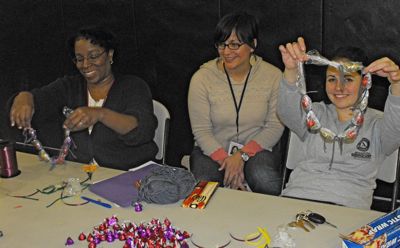
Those two photos represent the “chocolate” in the AmeriCorps-organized “Peace, Love, Chocolate” event at the Boys/Girls Club gym at Greenbridge today — top, Seattle’s own fair-trade, organic Theo Chocolate brought free candy; immediately above, volunteers made necklaces from Hershey chocolate kisses. And then, there were non-edible examples of peace and love, starting with kids creating art at this table – what you see hanging on the wall behind it is a “peace quilt” of paper:
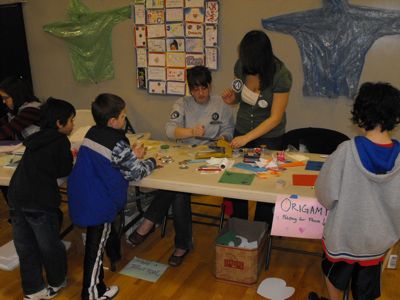
Of course, you can’t have a “peace” event in this area without representation from West Seattle Neighbors for Peace and Justice:
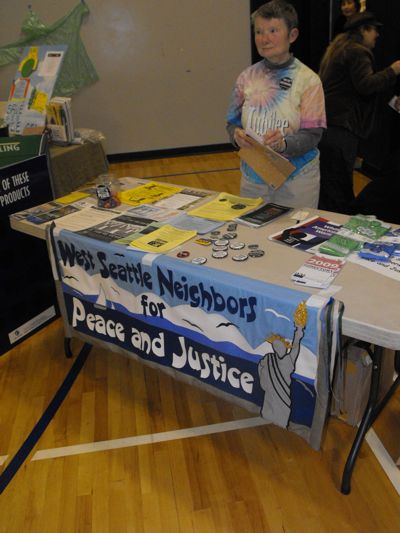
AmeriCorps volunteers who work for Habitat for Humanity in East King County kept watch over a table where these young helpers were creating with clay:

And if you think 4H is just about farms, this table was there to remind you that’s not so:
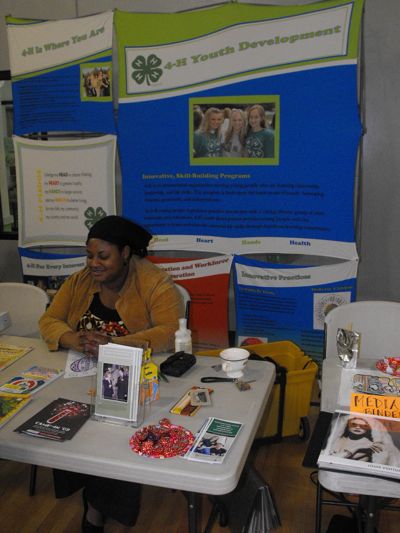
The event was a service project organized by AmeriCorps members including Yichuan Zhao, who kindly showed us around to the various stations (he also works with the White Center Food Bank, site of another event today that we’ll be writing about later). He and his AmeriCorps colleagues also are very appreciative of the many White Center businesses and organizations that helped them out and promised to send a list that we can add to this report (among them, White Center Now‘s own Cafe Rozella, which donated coffee, and Full Tilt Ice Cream, which sent paletas). Yichuan was proud to say that, thanks to donations and volunteer help, the entire event cost only $200 to put on – and that was to procure a PA system for live music! ADDED TUESDAY: Here’s the list of sponsors they wished to thank:
Food:
Full Tilt
Salvadorean Bakery
Carniceria El Paisano
Castillos
Samway Market
Cafe Rozella
Theo Chocolate
PCC
Trader Joe’s Burien
Albertson’s
Little Caesar’s
International MarketTables:
WSU 4-H
West Seattle Neighbors for Peace and Justice
Seattle Center for Peace
Powerful Voices
Solid Ground
Habitat for Humanity East King County (AmeriCorps Team)
ECOSSAnd people who donated stuff:
Goodwill (mugs)
Seward Park Clay Studio (Clay)Music:
Alex Kajumulo
Seattle Peace Choir
November 28th, 2008 Ricardo Posted in Crime, Development, Greenbridge, Real estate, Sustainability, White Center, White Center news Comments Off on Greenbridge: The Failure of the Cabrini-Green Model of Public Housing and the Rise of the New Urbanism
The modern debate on urban housing policy takes as its starting point the post-World War II period when the country invested heavily in developing cities and its suburbs. An outgrowth of the New Deal was the belief that government should ameliorate the problem of housing for those unable to afford the cost of commercial or private housing. The response to the housing problem was a mixture of modernist thought, good intentions, government bureacracy, racial attitudes and local politics. While this subject is vast and would require tomes to fully comprehend it, we are here most concerned with the present moment in Seattle’s urban design and specifically the philosophy behind the Greenbridge Project.
The model against which much of the current thinking pivots is the Chicago Housing Authority and its notorious housing projects such as the Cabrini-Green projects. Witold Rybczynski is an architect and an astute observer, with a sweeping knowledge of urbanism and a very accessible writing style. I was introduced to Rybczynski’s writing when I was designing a home about 15 years ago and happened upon his meditative tome, “The Most Beautiful House in the World.” Rybczynski took Cabrini-Green as a paradigm for the development of urbanism for a 1993 article entitled, “Bauhaus blunders: architecture and public housing – 1950s public housing estates Cabrini-Green, Chicago, Illinois, US“:
Cabrini-Green is but one of the most notorious housing projects known for its drab and sterile concrete towers of festering poverty, rampant crime, trash-strewn stairwells and unmitigated squalor. Most of the towers are now being torn down.
The oldest housing on the site dates from 1941, not long after the Housing Act of 1937 that signaled the first involvement of the federal government in funding housing for what there then called the deserving poor. Frances Cabrini Homes was named after a soon-to-be-canonized Chicago nun, famous for her charitable work, and it was built on the site of a notorious Italian-American slum kown as Little Hell. The new housing consisted of almost 600 dwellings in two- and three-story brick buildings; the total area of the project was relatively small: sixteen acres. The unassuming architecture of these row homes–every dwelling had its own front door on the street–was not substantially different from the popular urban housing then being built by the private sector in the surrounding city. The brick facades even incorporated some decorative elements. The overall design, like that of most prewar public housing projects, is modest but unremarkable; it was taken for granted that poor people would prefer to live lie everyone else. (emphasis added)
Although Cabrini-Green has become synonymous with large government-run slums, they were not the largest or worst of its kind. Hunt D. Bradford has written a concise piece on the Robert Taylor Homes, a larger Chicago Housing project in piece entitled, “What went wrong with public housing in Chicago? A history of the Robert Taylor homes.”
The consensus it that the project tended to congregate poverty and stigmatize the residents. As articulated by Rybczynski:
Although Cabrini-Green occupies almost as much land as the Loop itself, it is not the biggest public housing project in Chicago–that dubious honor belongs to Robert Taylor Homes, said to be the largest public housing project in the world. But Cabrini-Green was the first of the big projects, and it did become a model for how municipal authorities would rehabilitate deteriorated inner-city real estate and provide large amounts of public housing. The solution–bulldoze existing houses and replace them with tall apartment slabs spaced far apart in open parkland (created byh closing off existing streets to make immense “supper-blocks”)–reflected the prevalent social and architectural thinking of the time. As Bauer pointed out, his was not how the majority of Americans really lived–or would choose to live–but the idealistic housing reformers felt that they knew best.
Architects and planners maintained that high-rise buildings were better because they occupied less land, and provided their occupants with sunlight and unobstructed views, but the Chicago Housing Authority was probably attracted to Modern architecture for the same reason that many commercial developers were partial to the designs of Mies van der Rohe–their cost. The truth is that standardized, stripped-down, and undecorated tall buildings can be erected quickly and inexpensively. It is also likely that the plain architecture suited the puritan view of many Americans–and certainly of the housing reformers–who felt that social housing should not be fancy. Soon, utilitarian high-rise apartment towers were accepted as the best solution for public housing.
High-rise slums
However, it was one thing to build apartment towers for the upper-middle-class, as Mies did, and quite another to adopt them as solutions for housing the poor. The well-off have doormen, janitors, repairmen, and baby-sitters; the poor have none of these things. Without restricted access, the lobbies and corridors were vandalized; without proper maintenance, elevators broke down, staircases became garbage dumps, roofs leaked, and broken windows remained unreplaced; without baby-sitters, single mothers were stranded in their apartments, and children roamed unsupervised sixteen floors below. In Cabrini-Green, there were problems with the design of the buildings: To save money, no private balconies or terraces were provided, access galleries and elevator lobbies were left open to the elements (in frigid Chicago!), and despite the lack of air-conditioning, the unshaded apartment windows of the tall buildings faced east and west.
Equally unsuccessful was the overall layout which dispensed with the familiar street and supplanted it with parkland, although what little landscaping there was quickly disappeared and was replaced by beaten dirt and asphalt parking lots. In any case, the open pedestrian spaces were problematic: windy, unappealing, and more crime-prone than conventional streets and sidewalks overlooked by individual homes. In the name of housing the poor, the well-meaning social reformers of the 1950s invented a new type of urbanism, quite foreign to any previous American ideal of city planning. It is hardly surprising that the projects acquired a social stigma. This, as well as crime, drugs, and poor management, explains why today one-third of the apartments at Cabrini-Green remain unoccupied [and are now being demolished].
The reaction to the failure of Cabrini-Green style projects was a return to a style termed, the New Urbanism. Again, Rybczynski:
Which brings us to the Greenbridge, High Point and Holly Park developments in Seattle. Each of these projects reflects completely the philosophy of the New Urbanism and the rejection of the Cabrini-Green model. The development are designed to mix inhabitants of different income levels. As well, the housing is of a human scale with an emphasis on street life, walkability and sustainability. Most critically, these developments aim to look like housing, that anyone, regardless of their station in life, would choose to live in.
November 10th, 2008 Tracy Posted in Development, Greenbridge, White Center news Comments Off on Park Lake II update meeting this Thursday
Want to know what’s new with Park Lake II? The King County Housing Authority has a meeting planned at 6 pm Thursday, community room of the Nia Apartments (that’s the building that filled within days of its recent opening; 9935 8th SW in Greenbridge). Topics: Update on the “revitalization plan” for Park Lake II, and a discussion of its environmental review. Here’s the Google Street View of where you’ll be going for the meeting:
(You can click inside the Google Street View image and drag the cursor around to pan the image, without leaving this page!)
November 8th, 2008 Tracy Posted in Fun, Greenbridge, Video Comments Off on What’s happening at the (new) library
Now that the Greenbridge library branch is open, its events calendar is online – looks like kids’ story time, Thursday nights at 7 pm, is the big plan for now. Meantime, there’s a video clip we didn’t get around adding to our original coverage of Wednesday’s ribboncutting: a wonderful speech by King County’s Poet Laureate, Dr. Mona Lake Jones. Here’s the entire six minutes:
November 5th, 2008 Tracy Posted in Greenbridge, King County, Video, White Center news 1 Comment »
That’s County Executive Ron Sims, with brief informal comments about President-Elect Obama‘s victory, during this morning’s dedication of the YWCA Learning Center and new King County Library branch at Greenbridge. Here are the kids to whom he referred — White Center Heights Elementary School students who sang “Library Boogie” at the event:
As for the actual ribboncutting, we’ll add that visual in a bit. Meantime, you are welcome at an open house at the new facility, happening all day long, with special events including Story Time for kids 2-6, 1:45-2:45 pm. It’s in the 9700 block of 8th SW, just south of Roxbury (map).
October 6th, 2008 Tracy Posted in Education, Greenbridge, Video, White Center Early Learning Initiative 1 Comment »
After a series of speeches under a big (and yet standing-room-only) tent next to White Center Heights Elementary, those preschoolers from Learning Way helped U.S. Senator Patty Murray – one of the speakers – ceremonially break ground this morning for the Educare Learning Center at Greenbridge. (Official construction work starts tomorrow, according to WCH Elementary principal David Darling.) Lots more video and info to come.
September 20th, 2008 Tracy Posted in Development, Greenbridge, White Center news 2 Comments »
Announced by U.S. Senator Patty Murray’s office (read the announcement here): $20 million in federal funds confirmed for the King County Housing Authority’s Park Lake II redevelopment project. Murray says the White House had tried to cut the HOPE VI funding that included this money. Here’s a financial breakdown of the nearly $200 million going into Greenbridge. UPDATE: Per comments, King County notes that this portion of Park Lake redevelopment is for a project separate from Greenbridge.